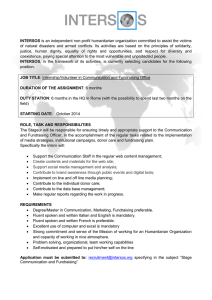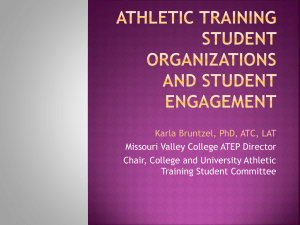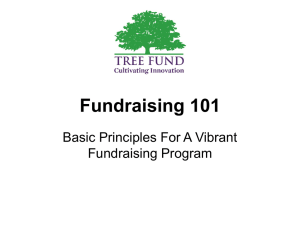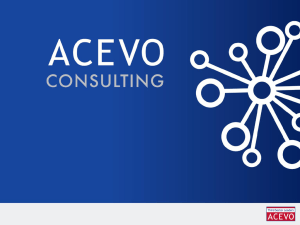The 5 things every charity needs to know about developing a
advertisement
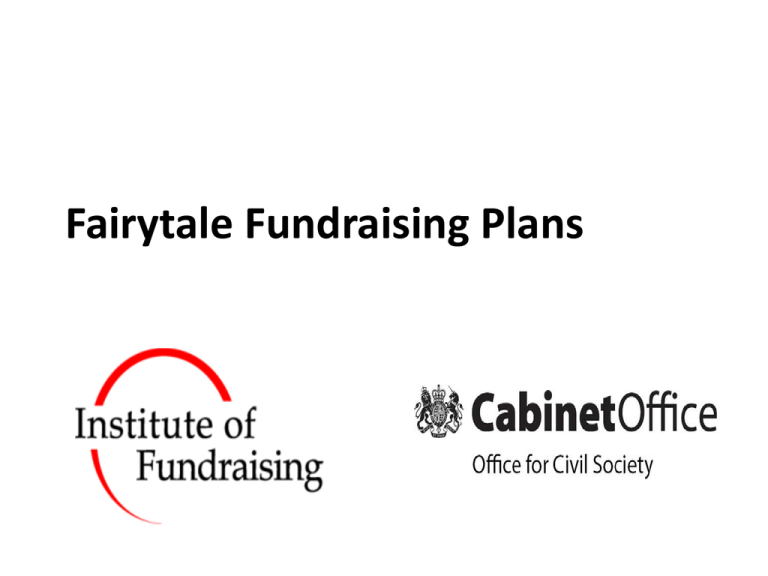
Fairytale Fundraising Plans Session 1 – GETTING STARTED: MISSION AND CHARACTERS Vision • Idealistic • How the organisation can achieve its ideals and the objects for which it was established • Example: “The NSPCC’s vision is of a society where all children are loved, valued and able to fulfil their potential.” Fundraising Planning 1. Business Mission 2. Organisational Objectives 3. Fundraising Audit 4. SWOT Analysis 5. Objectives and Key Strategies 6. Tactical Plans 7. Responsibilities 8. Schedule 9. Budget 10. Monitoring and Control 11. Contingencies Organisational Objectives • • • • • • • • Market Standing Innovation Productivity Financial and physical resources Manager performance and development Employee/volunteer performance and attitude Societal needs to be served Public/social responsibility Mission • All-embracing statement of what is to be achieved , in fulfilment of the mission Getting Started • Check your legal obligations and powers to fundraise in your governing document • Decide on a process for developing the strategy • Determine why you need to fundraise - To survive - To expand existing activities - To develop new activities - To broaden income base - To increase sustainability Fundraising Audit Framework STEEPLE Analysis Competitor Analysis Collaborative Analysis Market Analysis Analysis of Own Organisation Internal Analysis • • • • Past performance Portfolio analysis Processes Structure SWOT Analysis Strengths Weaknesses Opportunities Threats © Institute of Fundraising Internal External An effective Case Statement Mission and values Importance and urgency Specific objectives History and credibility What would happen if the appeal failed Amount required and timescale How the donor can help Objectives Long term Short term Hard objectives Soft objectives SMART Objectives Specific Measurable Achievable Realistic Timed From Strategic Aims to Fundraising Objectives Fundraising objectives are made up of three tiers - Strategic - Operational - Financial Session 2 – STARTING THE JOURNEY: CASE FOR SUPPORT, RESOURCES AND RESEARCH Research • • • • • • What do you need to know? Where can you find out? When do you need to know? Who can help? Who will do the research? How will this research inform the strategy? Session 3 – FRIENDS AND FOES: ADVISORS, SPECIALISTS AND SABOTEURS Internal Suppliers • • • • • • • Volunteers Manager/Director of Fundraising Marketing Team Finance Database Manager Other fundraising specialisms Trustees External Suppliers • • • • • • • • • List Broker Creative agency Media buyers Data Processing House Mailing House Fulfilment House Telephone Agency Product Supply Production Studio Managing Suppliers • • • • • • • • Prepare a clear brief Be realistic about expectations Plan them into your schedule Be clear about the deliverable outcomes Set deadlines with a contingency Consider the risks Monitor regularly Consider the relationship Briefing Suppliers State your requirements clearly, with measurable objectives Give them the context, your objectives Agree how and when monitoring will take place Session 4 – FINDING THE CURE: FUNDRAISING MIX, OPTIONS ANALYSIS The Fundraising Mix • • • • • • • Major Donors Legacy Regular Giving Events Online Corporate Trusts & Foundations Analysing a Funding Source Funder 1 Relevance to cause £’s available Past experience % match required Resources required Lead time Capital vs revenue % Duration Potential to reapply Monitoring procedures Overall rating Funder 2 Funder 3 Funder 4 Key Strategies • • • • Strategic Direction (Ansoff) Segmentation Positioning Branding Ansoff Matrix Fundraising, promotional and/or campaigning technique New Target groups or audiences Existing Existing New Improve existing approach Least risky Try out new techniques on existing supporters Intermediate risk Extend existing techniques to new groups Intermediate risk Try out new techniques with new groups Most risky Fundratios 2010 Corporate £5.32 Median RoI per £1 invested Trusts £9.49 Major Donor £2.91 Competitions £2.13 Special Events £1.62 DM Appeals £2.09 Committed Giving/Membership £3.43 House to House £3.05 Local Fundraising £2.86 Other £0.26 Copyright Institute of Fundraising & Centre for Interfirm Comparisons Session 5 – THE JOURNEY HOME: RISK, IMPLEMENTATION, POLICIES AND RESOURCING Risks & Contingencies Risks • What are the potential problems? Contingencies • What can be done to minimise the risks • What can be done to obviate any problems that occur? • What is needed to make it happen? Fundraising Systems & Procedures • • • • • • • • • Ethics Policy Fundraising/Donor Database Files & Records – Paper & Electronic Contact Log Sheet Procedures for seeking/providing references Correspondence protocols Accepting a donation Complaints Financial Discrepancies Work Plans Why use work plans in a fundraising strategy? • Pros • Cons Headings in a work plan • Tasks • Resources • Timescale • Who is responsible • Monitoring points GANTT Chart Resources for Fundraising • • • • • Who will be responsible for managing the work of the strategy? Who will select the team? Who should be in the team? How is the work managed? Belbin Team Roles Budget The budget is the financial expression of the plan Three year rolling budget One year budget sets immediate financial targets Session 6 – CURING THE MAIDEN, SAVING THE KINGDOM: MONITORING, EVALUATION AND SUSTAINABILITY Terms of Reference This should include: • Name • Background • Purpose of the group • Deliverable Functions • Composition of Membership & Roles • Reporting Structure • Meetings - Frequency - Quorum • Support for the Working Group Monitoring and Evaluation Monitoring is information for action Evaluation is about learning Monitoring & Evaluation Monitoring Evaluation • Understand the baseline • What is being evaluated? • What is being monitored? • Against what criteria • • • Develop appropriate monitoring systems & procedures Ensure all parties are aware of monitoring procedures Feed into the project management function • How - external/internal • When? • What is the purpose of the evaluation? • How will the results be disseminated? Sustainability These are often called ‘Exit Strategies’ and should include: • A demonstration of the long-term impact of funding on your organisation - Financial - Non Financial • An identified source of funding for the continuation of work beyond the term of the strategy • Mainstream lessons learned or models developed Sharing the Information • • • • • Trustees Staff Volunteers Funders Members
